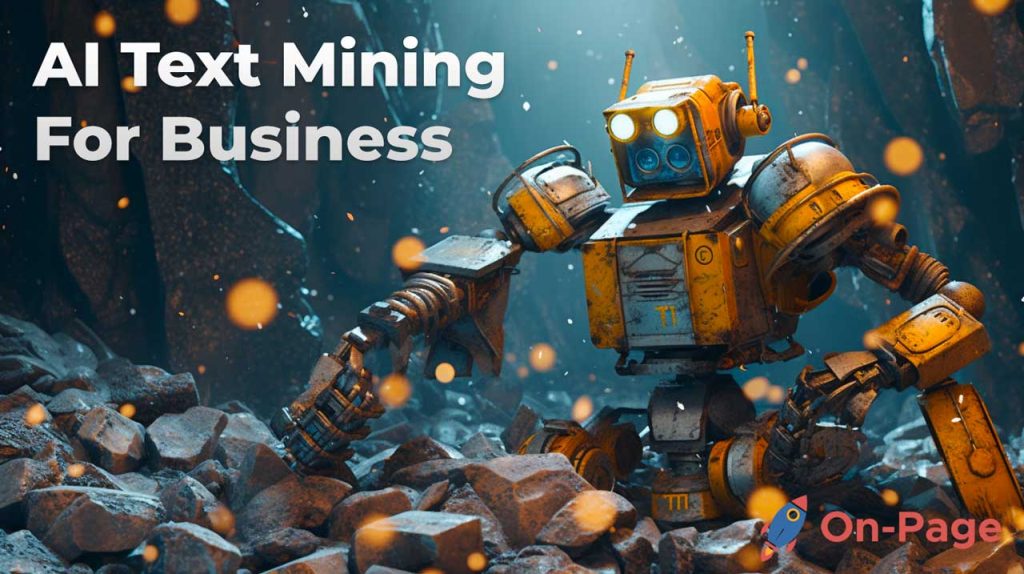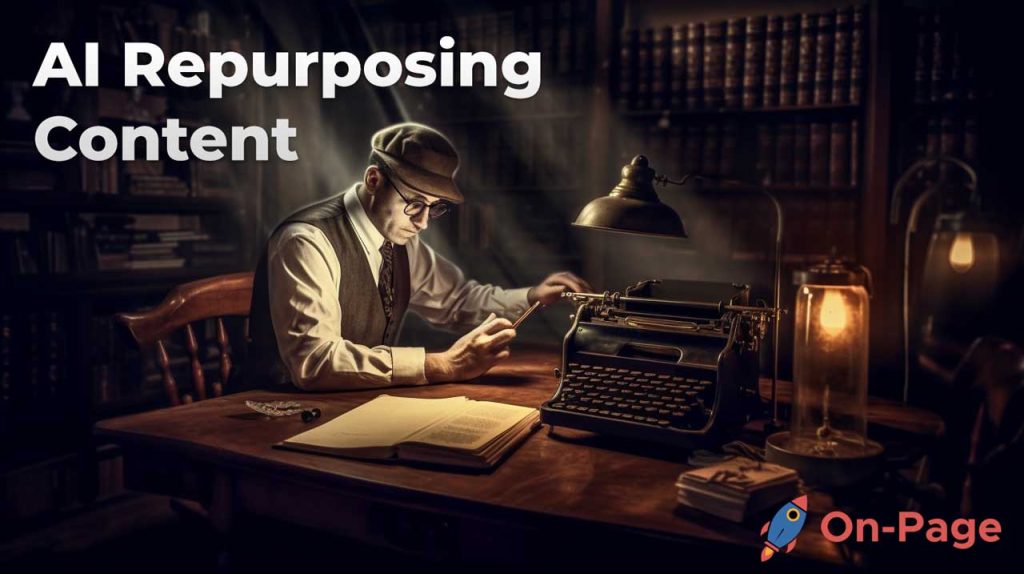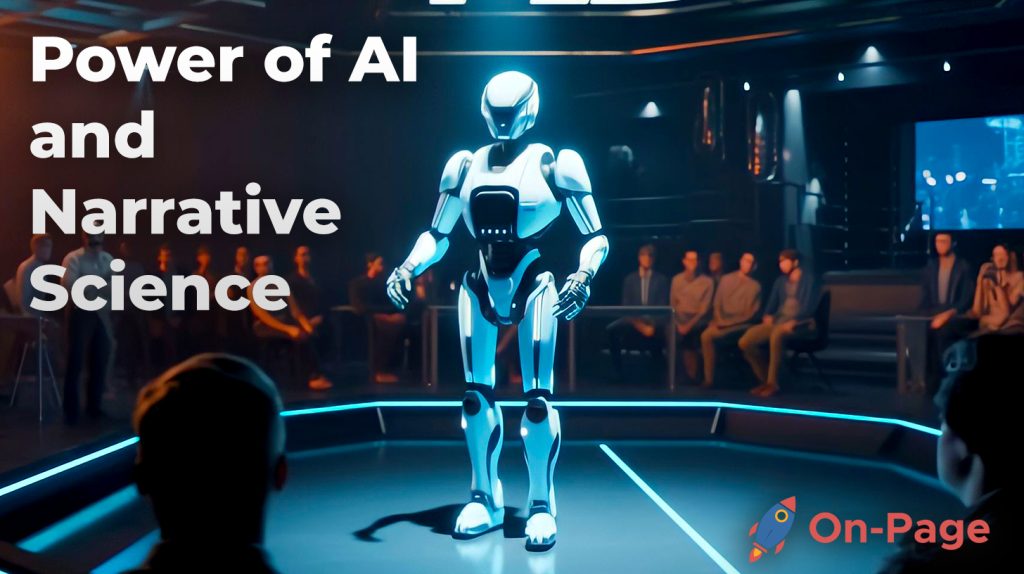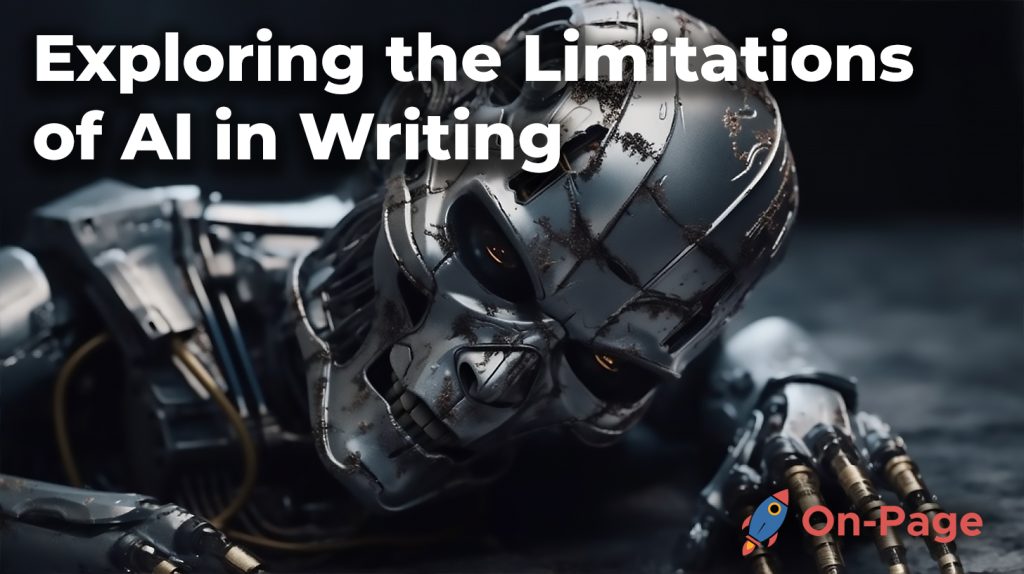
Picture yourself trapped in a room with an eloquent robot, effortlessly crafting the perfect prose while you struggle to find the right words. As AI-powered writing tools like On-Page AI continue to make strides in optimizing content and captivating audiences, it’s easy to wonder if humans will soon become obsolete—or if we’ve already reached the peak of AI’s capabilities in content creation. In today’s post, we’ll delve into the fascinating limitations of AI in writing and uncover what you truly need to know about this technological marvel. Brace yourselves as we embark on a journey where machines may master language and style, but human touch remains indispensable for true storytelling.
The limitations of AI in writing include difficulty understanding context, tone, and nuance, leading to potential misinterpretations or lack of emotional engagement. Limited creativity and originality are additional factors that can negatively impact shareability and engagement with content. While progress has been made in generating text, until these limitations are addressed through continued research and development, human writers will continue to produce superior writing over AI-generated content.
Defining AI in Writing
Artificial Intelligence (AI) is reshaping various industries, including writing and content creation. AI technology refers to a machine’s capability to perform any intellectual task that usually requires human intelligence, such as speech recognition, decision-making, language translation, and even writing. When it comes to writing, AI involves the use of sophisticated algorithms that can generate text similar to what a skilled human writer would produce.
AI writing tools have become more prevalent in recent years. These tools range from simple spelling and grammar checkers to complex content generators that can create articles from scratch. The purpose of these tools is to speed up the content creation process while improving its quality. In addition, they aim to help writers overcome writer’s block by providing them with ideas and inspiration.
However, there are certain limitations inherent in using AI for writing. Despite having made significant strides in natural language processing (NLP), machine learning models still lack the ability to completely understand the intricacies of human communication. This means that while capable of producing text that may seem coherent upon surface level analysis could be inaccurate or misleading if analyzed carefully.
For instance, consider a simple phrase like “He went up the stairs.” A human writer could interpret this phrase based on their understanding of context, such as the setting where this phrase was used, the personalities of characters involved, and other details within the text; whereas an AI program would only identify specific patterns present in data available to it without nuances and often generate a sentence irrelevant when read alongside other sentences in the paragraph or article.
Understanding how AI works regarding writing helps inform us about its influence on writing overall.
AI’s Impact on Writing and Content Creation

AI-generated content provides several benefits that have transformed the field of writing and content creation. It has revolutionized speed and efficiency by producing high-quality content faster than traditional writing. For instance, a human writer may take hours or even days to produce an informative and engaging article. With AI writing tools, however, writers can generate similar content in mere minutes.
Furthermore, the technology’s scalability has made it ideal for creating content on a large scale. This enables businesses and enterprises to meet their demands for high-volume output without having to sacrifice quality or accuracy. This is where On-Page.ai truly excels–in producing a ton of top-notch articles in just a few clicks. Its Stealth ReWriter can even recreate your existing content into brand-spanking new articles so you can repurpose them. While the Auto-Optimize feature can automatically optimize your articles and use your niche’s most profitable keywords. How amazing are these features?
It’s important to note that this process of utilizing AI to generate content is akin to using a recipe book. Just like how following specific instructions ensures that the dish will be prepared correctly every time; with AI, providing clear guidance and directions guarantees consistent text generation.
AI can help writers overcome the dreaded writer’s block by triggering inspiration and creativity through exposure to new ideas. This results from algorithms that analyze data available to them and provide suggestions for content creation, helping writers draft articles that are both informative and creative.
However, despite these benefits, there are drawbacks to using AI-generated content due to limitations associated with human-like understanding called deep context awareness.
Next, we will dive into these limitations and consider their impact on the use of AI in writing.
- AI-generated content has revolutionized the field of writing and content creation by increasing speed, scalability, and providing inspiration. This technology can create high-quality content in mere minutes, enabling businesses to meet high-volume output demands without sacrificing quality or accuracy. However, clear guidance and directions must be provided for consistent text generation. Despite its benefits, AI is limited by human-like understanding called deep context awareness. Future discussions are needed to explore the impacts of these limitations on its use in writing.
Speed and Efficiency Benefits
When it comes to speed and efficiency, AI writing tools offer a significant advantage over human writers. One of the main benefits of AI writing is that it can generate content much faster than humans. For instance, On-Page.ai’s Stealth Writer generates articles instantly by inputting a keyword and clicking on ‘generate’. This helps businesses meet the demand for quality content quickly and efficiently.
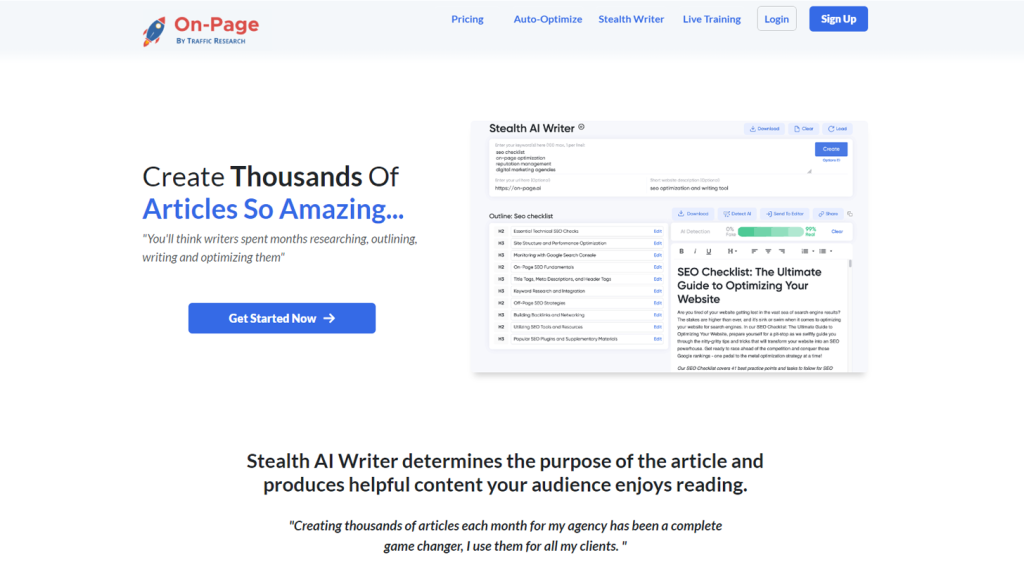
AI writing tools are also scalable in a way that human-written content is not. Businesses can produce large volumes of content quickly and easily using AI tools. This makes them ideal for meeting the needs of fast-paced businesses such as news websites, social media platforms, and e-commerce sites.
Consider a business that sells shoes online. The business needs to produce regular blog posts about shoe fashion, trends, and care to attract customers. With human-written content, creating high-quality blog posts regularly can be expensive and time-consuming. Using AI writing tools like On-Page.ai’s Stealth Writer makes it easy to create quality content without hiring writers.
Another advantage of AI writing tools is their ability to write consistently across multiple channels. They use machine learning algorithms that learn how to write in a particular style over time, ensuring consistency across all channels.
AI tools like the On-Page AI content optimization tool also have the advantage of being able to conduct extensive research within seconds, finding relevant information from reliable sources online. By analyzing the performance of existing content pieces, such as blog posts or social media promotions, they can generate new ideas for future content creation.
Think about how much time and effort it takes for a writer to research an article topic thoroughly. It requires reading books, scholarly journals, browsing websites on topics related to your industry and more! With AI-powered writing assistants on board, researching topics doesn’t take nearly as long or require such exhaustive research depth; all you need do is provide the topic you wish to cover, and AI will generate high-quality, in-depth content almost instantly.
Now that we have looked at the speed and efficiency benefits of AI writing, let’s explore how it helps relieve writer’s block and generates ideas efficiently.
Writer’s Block Relief and Idea Generation

Writer’s block is a problem facing every writer at some point. Regardless of how talented or experienced they are, finding inspiration can be difficult sometimes. However, AI writing tools can alleviate these challenges significantly.
Using AI-powered writing assistants like On-Page.ai’s Stealth Writer for brainstorming or composing a draft often offers alternative approaches to your topic. These tools provide writers with numerous pre-written sentence structures that allow them to start building sentences easily, generating new ideas for their content.
Instead of hours or days spent researching and creating content, AI-powered writing assistants present countless options that writers would spend hours developing without undue effort.
In addition to helping with writer’s block relief, some AI-powered writing assistants also offer text suggestions based on what you have already written before. They analyze the tone of your text and pick up changes in meaning or phrasing that may be inconsistent with your message allowing you to refine your work further.
Critics argue that the quality of content generated through AI can still raise concerns about its authenticity value and credibility. However, While such arguments may hold water for early simple models of AI software, today’s sophisticated programs like On-Page.ai account for tone context sensitivity making it an outstanding resource for nearly any type of blog post.
An AI writing tool can be likened to a GPS navigator; both are designed to help users arrive at their destination quickly by providing guidance in real-time. Just as a GPS guides drivers along the right path effectively, so do AI-powered writing assistants offer logical guidance on topics, providing users with various options to choose from ensuring that they reach their goal of creating excellent content.
As we have seen, AI-powered writing tools offer a range of benefits in terms of speed and efficiency, as well as the ability to relieve writer’s block and generate new ideas. However, these benefits are not without limits, as we’ll see in the next section.
- A 2020 research paper from Stanford University found that AI models like GPT-3, which are trained to generate human-like text, struggle with understanding context and maintaining coherence over long passages, producing plausible-sounding but ultimately nonsensical responses.
- According to OpenAI‘s original research paper on GPT-3, while the model is able to generate grammatically correct text, it still struggles with correctly answering questions across diverse topics, particularly when fine-grained reasoning is required.
- A study by McKinsey & Company found that AI-based content generation tools succeeded in producing high-quality outputs only 20% of the time for specialized subjects requiring expert knowledge or nuanced understanding, reinforcing the need for human intervention in these cases.
Limitations of AI in Writing

When it comes to writing, AI has made significant advancements in generating text. However, there are still major limitations when it comes to understanding context, tone and nuance in writing. The problem lies with the fact that writing is a complex form of communication that requires not only the ability to use language but also the ability to understand the context in which it is being used.
For instance, consider a news article about a politician resigning from office. The language used would differ based on whether the resignation was due to health issues, scandal or simply personal reasons. Without context, an AI model could generate content using generic templates, which could lack accuracy and be misinterpreted.
Along with context, tone is another critical aspect of writing. Tone sets the mood and helps establish a connection with the reader, creating an emotional bond that AI-generated content often lacks. For example, consider two articles discussing the same topic – one written by a human writer and one generated by an AI program. Even if both articles convey information accurately, their tone would differ greatly.
Fortunately, On-Page.ai takes plagiarism seriously. All of its AI-generated content are guaranteed plagiarism free and pass AI detection.
Another limitation of AI-generated content is plagiarism. While writers are expected to reference sources while writing articles or reports, AI models often pull information from existing articles without proper attribution and citation. This leaves them vulnerable to being flagged by search engines for plagiarism issues.
Additionally, think of the type of music created by composers versus that created by algorithmic models trained on top-performing tracks across streaming services like Spotify or Apple Music. Composers create unique pieces of music that have personality and emotion, while AI-written music can often feel like compilations of existing successful tracks stitched together.
All these limitations make it clear that AI should be considered as a writing assistant rather than a replacement for human writers.
Context, Tone, and Nuance Challenges
The limitations of AI also manifest in its challenges with context, tone and nuance. As mentioned earlier, context plays a significant role in determining the intent behind a piece of written text. Without adequate contextual information, AI models often struggle to understand what the writer means to convey.
Similarly, tone is heavily influenced by context and situational factors. Tone can range from formal or academic to friendly or conversational, depending on the intended audience, subject matter and goal of writing. AI models often lack the social and cultural background knowledge required to make informed decisions about tone.
Nuance refers to the subtle differences in meaning between words, phrases and sentences. These differences can have a profound impact on how readers interpret content, making nuance an essential component of effective writing. However, teaching AI models to understand nuance remains challenging due to the complexity involved in semantically processing natural language.
Additionally, according to Google’s guidelines for producing high-quality content which ranks better, readability plays a critical role. However, it remains one of the biggest challenges even for AI models backed by deep learning technology.
Thus while AI-powered writing tools are fast becoming popular for their writing efficiency and scalability, they have a long way to go before they can replace human writers completely. Despite these limitations, there is still room for businesses and individuals to take advantage of AI-powered writing tools as assistants and supplementary aides.
The limitations mentioned bring us towards considering future writing technologies which improve on these limitations without compromising E-E-A-T (experience, expertise, authoritativeness, and trustworthiness) criteria valued by search engines like Google.
Emotional Engagement and Originality Constraints
While AI is an efficient and convenient tool for content creation, it has its limitations when it comes to emotional engagement and originality. In fact, one could argue that these two elements are some of the most critical aspects of good writing.

Firstly, emotions play a significant role in how we connect with the content we read. Writing that resonates with its readers generates more engagement, shares, and genuine conversations around the topic at hand. However, despite its advancements, AI still lacks the capacity to understand emotions in the same way humans do. It is not equipped to convey complex feelings or subtle nuances that can evoke empathy or sensitivity in a reader. Because of this, AI-generated content tends to feel robotic or sterile.
Additionally, originality is increasingly important as search engine algorithms evolve to value unique and novel content over repetitive and duplicated text. The ability for writing to stand out from competitors is critical in ensuring that readers stay engaged and interested in your brand. Yet, AI lacks creativity and critical interpretation skills that allow writers to make unexpected connections between ideas and generate truly unique content.
In essence, while AI can produce text quickly and efficiently without sacrificing accuracy or technical information, it often falls short when it comes to evoking an emotional response from the reader or generating truly original insights.
For instance, think about a heartfelt story you might read on social media about an individual overcoming adversity. A human being will be able to communicate the depth of emotion far more effectively than any machine could ever hope to achieve. This is because humans have real-life experiences that help them relate to others’ emotions through their writing expressions.
In a way, using AI instead of humans for all your writing needs is like using a lawn mower instead of your own hands when mowing your yard. Sure, the lawn mower gets the job done quicker and requires less effort from you, but it lacks the finesse and attention to detail that only human hands can deliver.
Furthermore, research has supported the limitations of AI in writing original content. In a study conducted by OpenAI in 2020, AI-generated text was compared to human-generated text. While the AI-written material was technically accurate and grammatically correct, it lacked the depth and complexity of genuine human thought. Test subjects overwhelmingly preferred the human-written content over the AI-generated text due to its emotional appeal and capacity for real connections.
Some may argue that technical accuracy is all that is necessary in certain circumstances such as scientific reports or legal documents. However, even in these more technical fields, there are opportunities for creativity and connection-building through storytelling and other communication techniques.
The Future of AI and Human Collaboration in Writing

It would be a mistake to assume that AI will replace or even fully compete with human writers altogether. Rather than replacing humans completely, it is possible to harness the benefits of AI while still retaining the value of human creativity and emotion.
One potential future of writing could see AI generating more basic informational content while leaving creative and complex writing tasks to humans. This division of labor could leverage the speed and efficiency benefits of AI while ensuring quality original content remains a priority. For example, companies may use On-Page AI advanced SEO tool to create outlines for articles or blogs based on predetermined parameters such as website URL, topic focus, or keywords. Humans could then add their unique insight and emotional intelligence to produce a finished product that both appeals to readers’ emotions and adds value through creativity.
Another possibility is to use AI as a tool to assist human writers rather than replace them completely. Writing tools powered by AI could help with language translation, grammar checking, or suggesting appropriate context-sensitive vocabulary or phrasing. Such tools would provide an efficient way for authors or copywriters to quickly improve the quality of their writing without sacrificing creativity and individual style.
One example of successful AI/human collaboration can be seen in music production. Artificial intelligence systems are often used to generate basic beats, rhythms, and chord progressions that human music producers then expand on and refine. This division of labor allows for greater efficiency while still retaining the unique creative vision of the human producer.
Another interesting analogy could be found in the world of professional cooking. Just as a chef may use high-tech kitchen gadgets such as an immersion circulator to cook meat precisely, they still rely on their own knowledge and skill to create a unique dish that appeals to both taste and presentation. In the same way, AI will be the tool but not the master.
We have already seen some examples of AI-assisted writing tools come into play with organizations like Associated Press (AP) and Forbes using AI to produce automated news stories or other relatively simple content. However, there is still tremendous scope for future development in this field. As AI becomes more sophisticated, it has the potential to provide novel insights or generate unique ideas that humans may not have otherwise considered.

However, there is also the risk that with increased dependence on AI in writing comes a homogenization of writing styles or an overemphasis on technical accuracy at the cost of genuine human connections and emotional engagement.
Sure, there may be some limitations to using AI in writing. But its countless benefits far outweigh its drawbacks. Speed, efficiency, and accuracy are just some of the amazing advantages of using an AI writer like On-Page.ai.
Sign up now if you’re eager to learn more about how it can help boost your business’ content optimization and marketing strategy.

